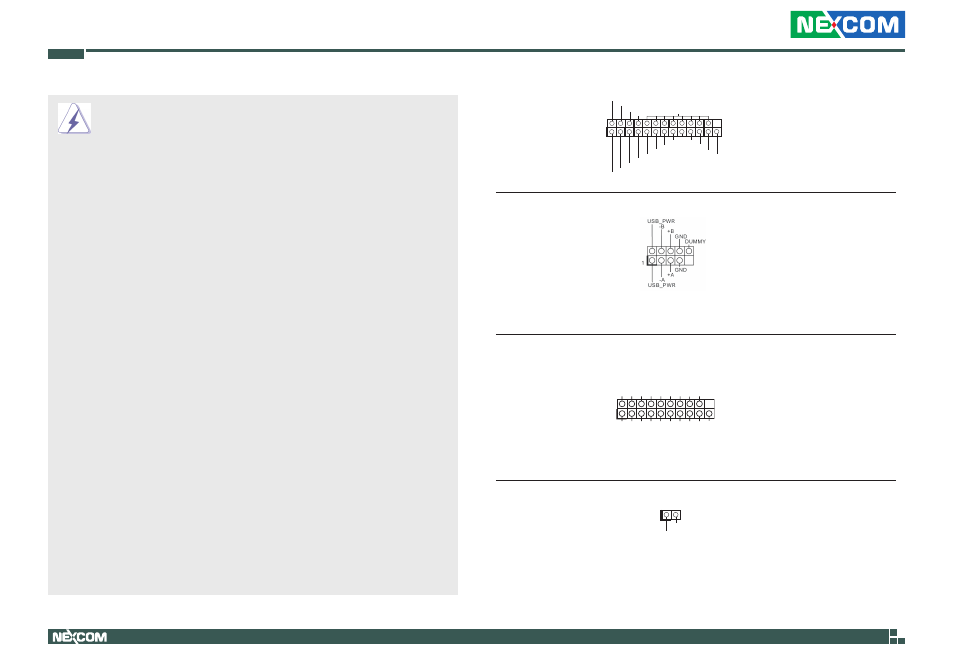Pwrbtn (power switch), Reset (reset switch), Pled (system power led) – NEXCOM NEX 980 User Manual
Page 26: Hdled (hard drive activity led), Chapter 2 : installation, Print port header this is an interface for print, Port cable that allows, Convenient connection of printer devices, Usb 2.0 headers besides four default usb 2.0, Ports on the i/o panel, there are

Copyright © 2013 NEXCOM International Co., Ltd. All Rights Reserved.
15
NEX 980 User Manual
Chapter 2 : Installation
Connect the power switch, reset switch and system status
indicator on the chassis to this header according to the pin
assignments below. Note the positive and negative pins before
connecting the cables.
PWRBTN (Power Switch):
Connect to the power switch on the chassis front panel. You may
configure the way to turn off your system using the power switch.
RESET (Reset Switch):
Connect to the reset switch on the chassis front panel. Press the
reset switch to restart the computer if the computer freezes and
fails to perform a normal restart.
PLED (System Power LED):
Connect to the power status indicator on the chassis front
panel. The LED is on when the system is operating. The LED
keeps blinking when the sys-tem is in S1/S3 sleep state. The LED
is off when the system is in S4 sleep state or powered off (S5).
HDLED (Hard Drive Activity LED):
Connect to the hard drive activity LED on the chassis front panel.
The LED is on when the hard drive is reading or writing data.
The front panel design may differ by chassis. A front panel
module mainly consists of power switch, reset switch, power
LED, hard drive activity LED, speaker and etc. When connecting
your chassis front panel module to this header, make sure
the wire assignments and the pin assign-ments are matched
correctly.
Print Port Header
This is an interface for print
(25-pin LPT1)
port cable that allows
(see p.8, No. 33)
convenient connection of printer
devices.
1
AFD#
ERROR#
PINIT#
GND
SLIN#
STB#
SPD0
SPD1
SPD2
SPD3
SPD4
SPD5
SPD6
SPD7
ACK#
BUSY
PE
SLCT
USB 2.0 Headers
Besides four default USB 2.0
(USB12: see p.8, No. 34)
ports on the I/O panel, there are
(9-pin USB8_9: see p.8, No. 37)
three USB 2.0 headers and one
(9-pin USB10_11: see p.8, No. 36)
USB 2.0 port on this
motherboard. Each USB 2.0
header can support two USB 2.0
ports.
USB 3.0 Header
Besides two default USB 3.0
(19-pin USB3_2_3)
ports on the I/O panel, there is
(see p.8 No. 35)
one USB 3.0 header on this
motherboard. This USB 3.0
header can support two USB
3.0 ports.
1
In
tA
_
P
B
_
D
+
D
u
m
m
y
In
tA
_
P
B
_
D
-
G
N
D
In
tA
_
P
B
_
S
S
T
X
+
G
N
D
In
tA
_
P
B
_
S
S
T
X
-
In
tA
_
P
B
_
S
S
R
X
+
In
tA
_
P
B
_
S
S
R
X
-
V
b
u
s
V
b
u
s
In
tA
_
P
A
_
S
S
R
X
-
In
tA
_
P
A
_
S
S
R
X
+
G
N
D
In
tA
_
P
A
_
S
S
T
X
-
In
tA
_
P
A
_
S
S
T
X
+
G
N
D
In
tA
_
P
A
_
D
-
In
tA
_
P
A
_
D
+
Chassis Intrusion Header
This motherboard supports
(2-pin CI2: see p.8, No. 38)
CASE OPEN detection feature
(2-pin CI1: see p.8, No. 41)
that detects if the chassis cover
has been removed. This feature
requires a chassis with chassis
intrusion detection design.
1
Signal
GND
